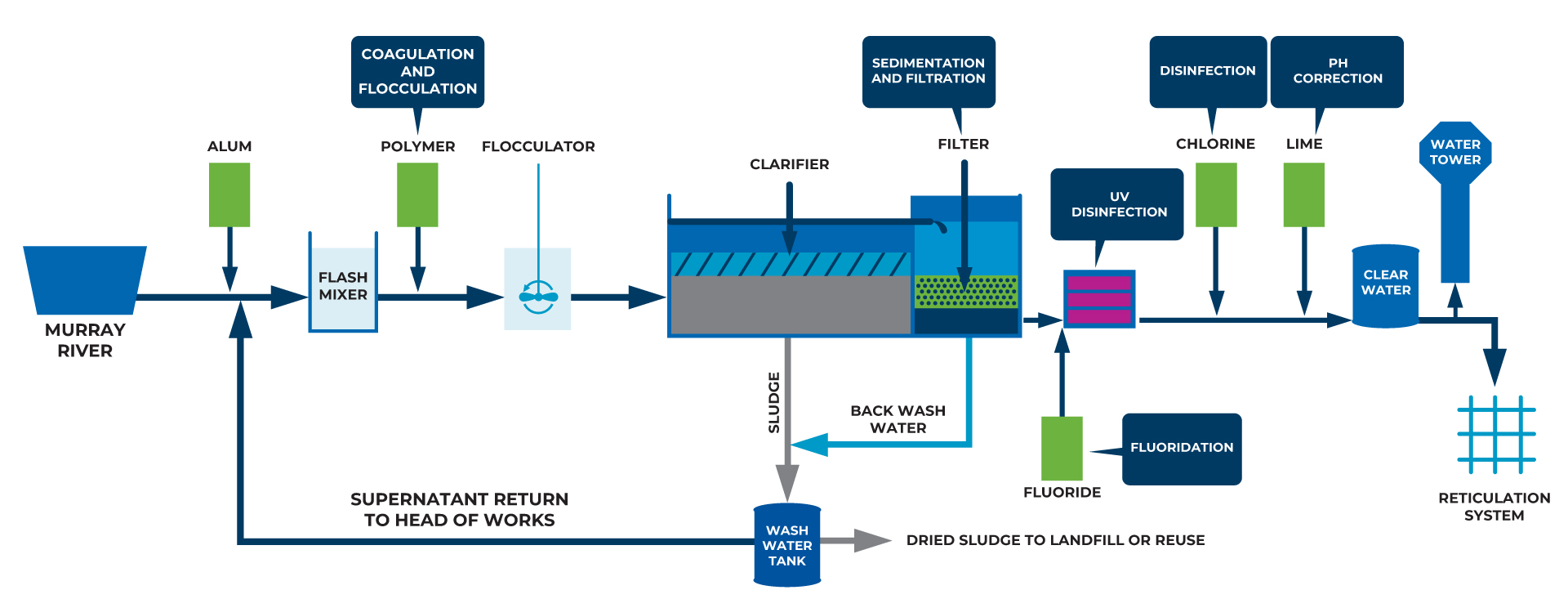Water treatment and testing
Find out how we treat and test our water to make it safe to drink.
We have 9 treatment plants across the region. Careful monitoring, testing and treatment makes sure the water is safe to drink.
We report on the quality of our drinking water in our Annual Drinking Water Quality Report and Monthly Water Quality Reports.
Water treatment process
Our treatment plants treat water to meet the national Australian Drinking Water Guidelines (ADWG) and the Victorian Safe Drinking Water Act 2003 (SDWA). Find out more about the steps in our water treatment process.

Step 1. Coagulation and flocculation
The first step of the treatment process involves dosing a chemical coagulant to help gather together solids and organic materials in the raw water. We use aluminium sulphate or aluminium chlorohydrate to bring about the coagulation process, which helps form larger particles called ‘flocs’ that can be more readily removed by subsequent treatment steps. Flocculant aids including polyelectrolytes are also commonly used to enhance this phase and further assists in the sedimentation and clarification processes.
Step 2. Clarification
Clarification is the same as the sedimentation process. It involves mixing the raw water with previously settled solids in a cylinder located in the centre of the clarifier. Gentle mixing within the reaction well promotes a cluster of floc particles. The greatest clarity is achieved when particles cluster together to create a thick layer , which we call the sludge blanket. Rotating sludge scrapers move settled solids to the centre of the basin for removal.
Clarified overflow is removed through a circular system that draws water from the entire surface area to prevent solids carryover caused by uneven velocity currents.
Step 3. Sedimentation and Filtration
Sedimentation is a step in the treatment process intended to enhance the filtration process, where particles are removed from the water by means of gravity or separation.
In the sedimentation process, the water passes through a relatively quiet and still basin. In these conditions, the floc particles settle to the bottom of the basin while ‘clear’ water passes out of the basin and on to the next stage of the treatment process.
The solids collected on the bottom of the basin are removed through a mechanical ‘sludge collection’ device at which scrapes the sludge to a collection point where it is pumped to the LMW re-use site on Cureton Avenue.
Filtration occurs as the water passes through sand filters that help remove any particles that have not settled in the sedimentation process. The sand filters contain layers of gravels, sands and filter coal. The sand filtration process removes fine suspended solid matter as well as some other particles including larger micro-organisms, resulting in clear water passing through.
Step 4. Fluoridation
Water fluoridation is the adjustment of fluoride in drinking water to a level that helps protect teeth against dental decay. Fluoridation of the drinking water supplies is undertaken as per the requirements of the Health (Fluoridation) Act 1973.
Step 5. Disinfection
Water is disinfected with UV (Ultraviolet) treatment and chlorination to kill any pathogens (disease-causing organisms) that remain in the treated water after filtration and provide protection within the distribution system.
Without disinfection, the risk from waterborne disease is greatly increased. Disinfection is carried out by chlorination in the form of chlorine gas.
Step 8. pH correction
Due to the addition of coagulants and chlorine, the pH (acidity) of the water being treated is lowered, becoming more acidic. To inhibit corrosion and make the water safe to use, the pH is adjusted to a neutral pH, about pH 7.0, by adding lime or other alkaline chemicals such as soda ash or sodium hydroxide.
Monitoring and testing
We monitor our water to make sure the water delivered to our customers meets water quality standards.
Water samples are collected from treatment plants and customer taps. The samples are tested by an independent laboratory that is accredited by the National Association of Testing Authorities (NATA) and approved by the Victorian Department of Health.
Microbiological tests
Water is tested to make sure it’s free from micro-organisms that can cause disease. These tests measure the presence of E. coli and the total number of coliforms, or bacteria, which indicate possible contamination from sources such as human or animal waste. Water is also tested for Cryptosporidium and Giardia.
Physical and chemical tests
The physical characteristics of water relate to its appearance, taste, odour and ‘feel’, as well as the corrosion or scaling potential of the water.
Physical testing includes colour, turbidity and pH. Turbidity is a measure of the number of particles present in the water (high turbidity causes a cloudy appearance).
Chemical tests are conducted for a range of substances, including chlorine and other disinfection by-products and aluminium. These tests identify substances that may be naturally occurring or added to the water during the treatment process for health or aesthetic purposes.
Water is also tested for a range of health-related inorganic and organic components as well as for pesticides and herbicides.
Risk management
A drinking water quality management plan encompassing hazard analysis and critical control points (HACCP), is in place for all our urban supplies.
HACCP is an internationally recognised system that identifies and manages significant risks at key points in the water production process.
Untreated water supplies
Not all water is treated or safe to drink. Untreated water supplies include some town water supplies, irrigation water and water extracted by private diverters.
See Safe drinking water to find out more about your town’s water supply.